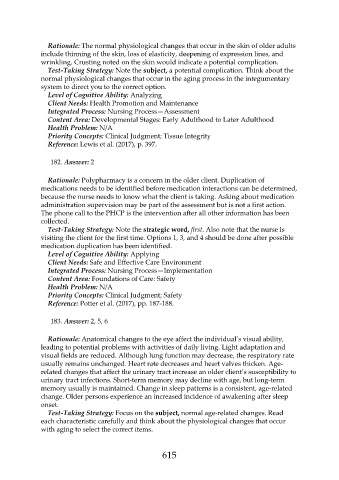Page 615 - Saunders Comprehensive Review For NCLEX-RN
P. 615
Rationale: The normal physiological changes that occur in the skin of older adults
include thinning of the skin, loss of elasticity, deepening of expression lines, and
wrinkling. Crusting noted on the skin would indicate a potential complication.
Test-Taking Strategy: Note the subject, a potential complication. Think about the
normal physiological changes that occur in the aging process in the integumentary
system to direct you to the correct option.
Level of Cognitive Ability: Analyzing
Client Needs: Health Promotion and Maintenance
Integrated Process: Nursing Process—Assessment
Content Area: Developmental Stages: Early Adulthood to Later Adulthood
Health Problem: N/A
Priority Concepts: Clinical Judgment; Tissue Integrity
Reference: Lewis et al. (2017), p. 397.
182. Answer: 2
Rationale: Polypharmacy is a concern in the older client. Duplication of
medications needs to be identified before medication interactions can be determined,
because the nurse needs to know what the client is taking. Asking about medication
administration supervision may be part of the assessment but is not a first action.
The phone call to the PHCP is the intervention after all other information has been
collected.
Test-Taking Strategy: Note the strategic word, first. Also note that the nurse is
visiting the client for the first time. Options 1, 3, and 4 should be done after possible
medication duplication has been identified.
Level of Cognitive Ability: Applying
Client Needs: Safe and Effective Care Environment
Integrated Process: Nursing Process—Implementation
Content Area: Foundations of Care: Safety
Health Problem: N/A
Priority Concepts: Clinical Judgment; Safety
Reference: Potter et al. (2017), pp. 187-188.
183. Answer: 2, 5, 6
Rationale: Anatomical changes to the eye affect the individual’s visual ability,
leading to potential problems with activities of daily living. Light adaptation and
visual fields are reduced. Although lung function may decrease, the respiratory rate
usually remains unchanged. Heart rate decreases and heart valves thicken. Age-
related changes that affect the urinary tract increase an older client’s susceptibility to
urinary tract infections. Short-term memory may decline with age, but long-term
memory usually is maintained. Change in sleep patterns is a consistent, age-related
change. Older persons experience an increased incidence of awakening after sleep
onset.
Test-Taking Strategy: Focus on the subject, normal age-related changes. Read
each characteristic carefully and think about the physiological changes that occur
with aging to select the correct items.
615

